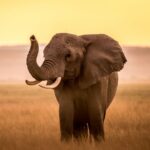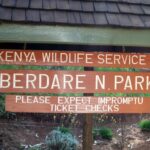Lake Nakuru National Park is one of the best-recognized national parks in Kenya for its many natural attractions and scenic beauty. The park is named after one of the Rift Valley soda lakes, the Lake Nakuru.
This park is home to a wide variety of bird species especially the famed flamingos and many more naturalist and wildlife enthusiasts will not want to miss out on a trip to this park.
History of Lake Nakuru National Park

The history of the natural conservation area of Lake Nakuru was established in 1957 and since then so much has happened. Initially, this park was established to safeguard the colonizing flamingos and other breeds of birds around Lake Nakuru.
It became a bird sanctuary in 1961 and was later formally nominated as a national park in 1968. Since then and over the years the park has grown and developed to cover an area of 188sq.kilometres.
It has also adopted its status as a haven for endangered species such as Rothschild’s giraffe and both black and white rhinoceros.
Wildlife and Birdlife at Lake Nakuru National Park

Originally, the park was established for the conservation of animals such as Flamingos and other bird species. Birding is a popular activity in the park because over 400 bird species call the park home. Among the more famous birds around the lake is the flamingo whose large numbers make the shores of the lake pink at certain times.
It is also home to other birds such as the African Fish Eagle, Montane White-eye, Slender-billed Greenbul, and many more.
Some of the other features associated with mammals in the area include the following; There are over 50 mammal species in the park; the critically endangered Rothschild’s giraffe, lions, leopards, buffalos, and waterbucks among others.
It also has a Rhino conservation area where black and white rhinos are known to graze in the park. Due to the numerous conservation measures implemented, viewing the astonishing animals in Lake Nakuru is among the best experiences one can have in Kenya.
Attractions in Lake Nakuru National Park

Lake Nakuru which is the main feature of the park is a shallow, alkaline, soda lake that hosts over two thousand flamingos. The water of the lake is alkaline which provides feed for growth of algae which in turn are consumed by the flamingos making it a beauty to watch them congregate along the shores of the lake. It is also a very important location for birding since there are many other bird species living in and around the lake.
Makalia Waterfalls: The Makalia Waterfalls are a natural feature of the park which is found in the southern part of the park. The water in the falls enhances the beauty of the place especially if viewed after the rainy season has begun. This place is also suitable for having a picnic or going for a hike as it is surrounded by nature.
Baboon Cliff and Other Viewpoints: There are several vantage points to the viewpoints in the park, of which the Baboon Cliff is one, whereby tourists observe the view over the entire park, the lake and the vista of the entire tract of land around the lake. These viewpoints are ideal for taking pictures and offer a good chance to observe animals in the wild.
Rhino Sanctuary: Its rhino sanctuary is one of its prominent features, but I am not sure whether they offer any dangerous animal encounters to the guests. It is a unique experience to see them in the wild, both black and white rhinos, in their natural environment. The sanctuary is therefore enclosed by a fence to help prevent rhinos from being killed by poachers which would endanger the existence of the animals in the wild.
Wildlife Viewing: Apart from the rhinos, other animals that are easily observed by anyone visiting the Lake Nakuru National Park include lions, leopards, giraffes, zebras, and many others. Game drives are perhaps the most effective ways of moving around the park and accessing the wildlife.
Activities in Lake Nakuru National Park
Game Drives: Driving around in a car to observe the park’s wildlife is the most preferred activity by visitors within Lake Nakuru National Park. These drives regardless if in the morning or in the evening offer the most spectacular views of the park’s terrains.
Bird Watching: In fact, bird-watchers are really lucky since every part of the Lake Nakuru National Park is a bird watcher’s paradise. A trip to the island is not complete without observing birds, of which there are well over 400 species and flamingoes. If you are interested in bird watching, then the most ideal places to watch them would be along the shores of the lake and at vantage viewing points in the park.
Hiking and Picnicking: Another form of recreation is hiking and that means enjoying the park with a picnic basket in tow. Some of the vantage points like the Baboon Cliff are accompanied by great hiking trails where the hiker is rewarded with great views at the summit. Other recommended destinations for a beautiful walk and a delicious meal include Makalia Waterfalls.
How to Get to Lake Nakuru National Park

This park is conveniently located not far from Nairobi and is suitable for one-day trips as well as for multi day safaris. The park can be reached by:
By Road: It takes approximately 3.5 hours to drive from Nairobi to Lake Nakuru. Main entrance is at strategic position close to the Nakuru township while on the drive one gets elegant view on the Great Rift Valley.
By Air: For those who fancy flying, the Naishi airstrip found within the park are easily accessible. A flight from Nairobi to Naishi airstrip takes approximately 25 minutes.
Accommodation Options in Lake Nakuru National Park

Lake Nakuru National Park offers a range of accommodation options to suit different budgets and preferences:
Luxury Lodges:
- Flamingo Hill Tented Camp: This camp is found in the northern part of the park which provides an opportunity for luxury tented accommodation with a view of Lake Nakuru.
- Mbweha Camp: This luxury camp is located in the southern part of the park and has rustic cottages with exclusive services as well as various tasty bush lunches available.
Midrange Lodges:
- Lake Nakuru Lodge: A luxury accommodation that has environmental conservation as its key point and features excellent views of the countryside. There is a lodge that has its own restaurant which offers African, Indian, and American dishes.
Budget Options:
- Makalia Camp: An inexpensive camping site that is in close proximity to Makalia Waterfalls. The camp is preferred by those seeking to spend time close to nature.
Camping:
- Rhino Campsite: A campsite that is 38km from the park gate and one of the most visited. The accommodation is very primitive and is situated right in the middle of the park with very minimal amenities.
Best Time to Visit Lake Nakuru National Park
It is advisable to visit the Lake Nakuru National Park during the dry seasons, which, are June to October, and January to March. During these times, most minor streams, which provide water in the park, dry up and this makes the animals to be easily spotted round the lake.
The dry season also provides the best natural environment for conducting game drives and other related exercises.
Why Visit Lake Nakuru National Park?

This park is one of the most remarkable attractions in the country since here you can observe most of the Kenyan species of wildlife in a small territory. There are many recreational activities that one can undertake depending on personal interests; bird watching, wildlife viewing, and scenic viewing of the park, especially the famous Lake Nakuru.
It is close to Nairobi and can therefore be considered for a day trip or an extended safari; it is also home to a rhino sanctuary thus adding the conservation aspect to your trip.
Discover why Lake Nakuru National Park is one of Kenya’s most prized natural assets by travelling through the park. Be it the flamingos, the rhinos, or the amazing scenery, a visit to this park you will never forget the natural resourcefulness of Kenya.





